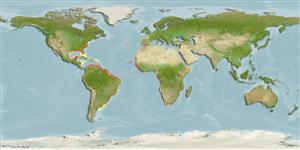Common names from other countries
Пластиножаберные (акулы и скаты) (sharks and rays) >
Myliobatiformes (Stingrays) >
Gymnuridae (Butterfly rays)
Etymology: Gymnura: Greek, gymnos = naked + Greek, oura = tail (Ref. 45335).
More on authors: Bloch & Schneider.
Issue
Species complex include Gymnura lessae and
Gymnura sereti; distribution of and both species were included for Gymnura micrura. Distribution will be corrected.
Environment: milieu / climate zone / depth range / distribution range
экология
морской; солоноватоводный демерсальный; пределы глубины ? - 55 m (Ref. 27549). Deep-water
Southwestern Atlantic: Venezuela, including Trinidad and Tobago, to Brazil (Rio de Janeiro).
Length at first maturity / Size / Вес / Возраст
Maturity: Lm 35.0, range 34 - 50 cm
Max length : 137 cm WD самец/пол неопределен; (Ref. 4439); common length : 90.0 cm WD самец/пол неопределен; (Ref. 5217); наибольший вес (опубликованные данные): 0.00 g
Broad, diamond-shaped ray with a very short tail lacking a dorsal spine (Ref. 26938). Snout protruding. Front edges of disk concave. Tail with low dorsal and ventral finfolds and 3 - 4 dark crossbars (Ref. 7251). Upper surface gray, brown, light green or purple with round spots. Lower surface white (Ref. 6902).
Prefers neritic waters of the continental shelf and
usually found on soft bottoms. May enter brackish
estuaries or hyper-saline lagoons (Ref. 5217). Feeds on
fish and shrimps (Ref. 28587); other crustaceans and clams
(Ref. 27549). Ovoviviparous (Ref. 50449). Generally
marketed salted (Ref. 5217).
Exhibit ovoviparity (aplacental viviparity), with embryos feeding initially on yolk, then receiving additional nourishment from the mother by indirect absorption of uterine fluid enriched with mucus, fat or protein through specialised structures (Ref. 50449). Distinct pairing with embrace (Ref. 205).
Yokota, L. and M.R. de Carvalho, 2017. Taxonomic and morphological revision of butterfly rays of Gymnura micrura (Bloch & Schneider, 1801) species complex, with the description of two new species (Myliobatiformes: Gymnuridae). Zootaxa 4332(1):1-74. (Ref. 116399)
Статус Красного Списка МСОП (Ref. 130435)
CITES (Ref. 128078)
Not Evaluated
Угроза для людей
Harmless
Использование человеком
рыболовство: не имеет хозяйственного значения
дополнительная информация
инструменты
Специальные отчеты
Скачать в формате XML
ресурсы в Интернет
Estimates based on models
Preferred temperature (Ref.
115969): 21.8 - 27.9, mean 25 (based on 544 cells).
Phylogenetic diversity index (Ref.
82804): PD
50 = 0.5000 [Uniqueness, from 0.5 = low to 2.0 = high].
Bayesian length-weight: a=0.00513 (0.00312 - 0.00843), b=3.10 (2.95 - 3.25), in cm Total Length, based on LWR estimates for this species & (Sub)family-body (Ref.
93245).
Trophic level (Ref.
69278): 3.6 ±0.53 se; based on food items.
устойчивость к внешним воздействиям (Ref.
120179): очень низкий, минимальное время удвоения популяции более 14 лет (Fec=3).
Fishing Vulnerability (Ref.
59153): Moderate to high vulnerability (51 of 100).
